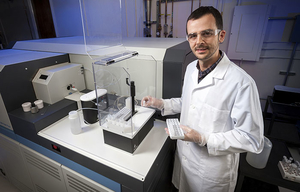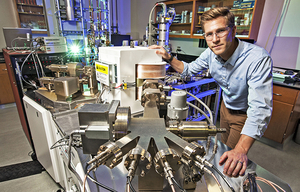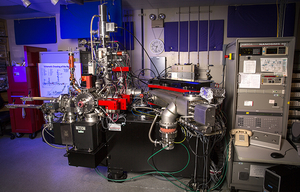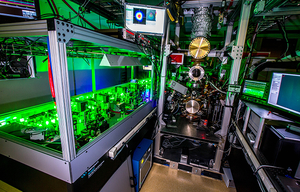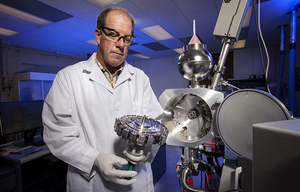LLNL’s sophisticated mass spectrometry instruments enable nuclear chemists, cosmochemists, and radiochemists to tackle complex science challenges.
Inductively Coupled Plasma Mass Spectrometry (ICP-MS)
Our ICP-MS instruments offer fast, precise ionization, allowing scientists to quantify trace levels of impurities in a range of elements and measure isotopic compositions of environmental, nuclear, and extra-terrestrial samples.
Our facility houses single-collector ICP-MS instruments as well as three multi-collector ICP-MS instruments that can measure multiple isotopes simultaneously. Our multi-collector ICP-MS instruments provide isotope ratio measurements on actinides, tungsten, lead, tellurium, zinc, and others, and our researchers offer preparation and certification of reference materials.
These instruments are a mainstay of LLNL’s nuclear science capabilities and support our research in radiochronometry, nuclear safeguards, and forensic analysis of nuclear material.
Livermore Noble Gas (LNG) Laboratory
The LNG Lab is a state-of-the-art facility for noble gas isotope ratio and abundance measurements. Instruments include a membrane-inlet mass spectrometer and a multi-collector noble gas mass spectrometer.
The laboratory supports cross-disciplinary research in the fields of national security, nuclear chemistry, inertial confinement fusion, planetary science, and Earth science. In addition to these applications, innovative research on theoretical and methodological aspects of noble gas chemistry and mass spectrometry are actively pursued in the laboratory.
Ongoing research efforts include constraining ancient climate conditions on Mars through the study of trapped gases in Martian meteorites, diagnosing implosion conditions at the National Ignition Facility using radioactive gases, and developing methods to age-date nuclear fuel cycle materials using noble gases.
Additional information is available on the LNG Lab website.
NanoSIMS (Secondary Ion Mass Spectrometry)
Secondary ion mass spectrometry (SIMS) is a spatially resolved, high-sensitivity method for obtaining trace element and isotopic information from solid samples. The sample is sputtered with an ion beam, generating secondary ions that are analyzed by mass-to-charge. Detection efficiency can be as high as 10 percent of the atoms in the sample—or many orders of magnitude lower—and mass resolving power can be on the order of 1 in 10,000, providing high mass specificity.
LLNL’s suite of imaging SIMS instruments includes a NanoSIMS 50, which has 50-nanometer spatial resolution, and two standard SIMS instruments. With these capabilities, a wide range of solid samples can be analyzed, including polished and ultramicrotome sections; focused ion beam foils; and particle, cell, and biofilm dispersions. LLNL scientists use SIMS for research in nuclear forensics, nonproliferation, bioforensics, biofuels, soil carbon, bioscience, cosmochemistry, geoscience, materials science, optics, and more.
Resonance Ionization Mass Spectrometry (RIMS)
LLNL’s laser ionization of neutrals (LION) laboratory supports nuclear forensics investigations with world-class expertise and finely tuned instrumentation. A key technology in this effort is resonance ionization mass spectrometry (RIMS). LION scientists use RIMS to analyze nuclear material for information about its origin, composition, and intended use. Basic science studies include analyzing stardust grains to learn how stars create atoms.
The RIMS instrument, custom designed at LLNL, measures isotope ratios in situ. Using lasers tuned to unique resonant frequencies that ionize only the atoms of a specific element, RIMS can measure samples with precision, consuming only a tiny portion of the material. As one of only a few RIMS facilities in the world, LION is developing solutions to today’s nuclear forensics challenges.
Stable Isotope Mass Spectrometry
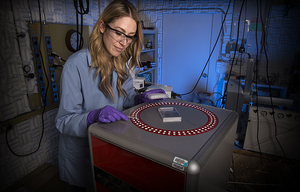
In our stable isotope mass spectrometry laboratory, our scientists measure precise natural abundance ratios of hydrogen, carbon, nitrogen, oxygen, and sulfur in nearly any material or phase.
Thermal Ionization Mass Spectrometry (TIMS)
Our scientists use TIMS to analyze elements with low ionization energy, providing precise isotope ratio measurements of chrome, lead, barium, and rare-earth elements. This technology enables scientists to perform highly reproducible analyses of small sample sizes and achieve part-per-million resolution for a range of materials.
TIMS-based studies expand our understanding of our solar system and support nuclear forensics efforts to make our world a safer place. These capabilities are a key part of LLNL’s research partnership with the National Aeronautics and Space Administration (NASA)—including the study of lunar rocks collected during Apollo missions to expand our understanding of the moon’s geologic history—and have numerous applications for nuclear forensics, cosmochemistry, geochemistry, geochronology, and environmental science.

